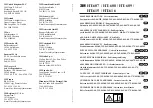
IV RIDING THE VEHICLE
This will possibly result in a straight line slide of the vehicle. Again, the best advice
is to safely reduce speed in anticipation of a maneuver so to give yourself time and
distance to regain total vehicle control before it spins out of your control.
As you drive your ATV over a loose snow covered surface, snow dust will be
picked up in the wake turbulence of the moving vehicle and transported to contact
and accumulate or melt on some exposed components including rotating parts
like brake discs. Water, snow or ice may affect the response time of the brake
system of your ATV. Even when not required to reduce vehicle speed apply brakes
frequently to prevent ice or snow accumulation and to dry brake pads and discs.
While doing so in low risk driving situations you will test for grip level and keep
yourself alerted to how the vehicle reacts to your control inputs. Always keep
brake pedal, footrests, floor boards, brake and throttle levers free of snow and ice.
Frequently wipe snow off seat, hand grips, headlights, taillights and reflectors.
The depth of the snow cover may hide rocks, tree stumps or other objects and if it
is wet may totally impede the driveability as the vehicle becomes bogged down or
completely looses traction in slushy snow. Look far ahead and always be watchful
of any visible clues that might indicate the presence of such obstacles. In doubt
steer clear. Avoid driving on any frozen body of water before checking that the
ice will safely support the ATV, its riders and its load of cargo. Remember that a
given thickness of ice may be sufficient to support a snowmobile but not an ATV
of an identical weight because of the smaller load bearing surface of the four tire
contact patches as compared to that of a snowmobile track and skis.
To maximize comfort and avoid frostbite, always wear clothing and ATV protective
equipment appropriate for the weather conditions you will be exposed to during
your ride.
At the end of each ride it is a good practice to clean the vehicle body and all moving
components (brakes, steering components, drivelines, controls, radiator fan etc.)
from any snow or ice accumulations. Wet snow will turn to ice during the shut
down period and become more difficult to remove at the next pre-ride inspection.
Riding in snow may reduce the brakes stopping capability. Safely reduce speed
and allow greater distance for braking. Snow projection may cause ice build up or
snow accumulation on brake components and controls. Apply brakes frequently
to prevent ice or snow accumulation.
Riding on Sand
Riding on sand, sand dunes or on snow is another unique experience, but there are
some basic precautions that should be observed. Wet, deep or fine sand/snow
may create a loss of traction and cause the vehicle to slide, drop off or become
“bogged” down. If this occurs look for a firmer base. Again, the best advice is to
slow down and be watchful of the conditions.
When riding in sand dunes it is advisable to equip the vehicle with an antenna type
safety flag. This will help make your location more visible to others over the next
sand dune. Proceed carefully should you see another safety flag ahead. Since the
antenna type safety flag can snag and rebound on your body if caught, do not use it
in areas where there are low hanging branches or obstacles.
60
_______
A) SAFETY INFORMATION
_______
Summary of Contents for OUTLANDER 6x6 T 2021 Series
Page 13: ...A SAFETY INFORMATION ________A SAFETY INFORMATION _______ 11...
Page 87: ...B VEHICLE INFORMATION _______________ 85...
Page 88: ...I CONTROLS 219002091 101 TYPICAL 86 ______________...
Page 102: ...III EQUIPMENT 219002091 100 TYPICAL 2 UP MODEL SHOWN 100 ______________...
Page 130: ...INSTRUCTIONS FOR VEHICLE LIFTING This page is intentionally blank 128 ______________...
Page 131: ...C MAINTENANCE ______________ 129...
Page 165: ...D TECHNICAL INFORMATION ______________ 163...
Page 166: ...EC DECLARATION OF CONFORMITY DoC_ATV_MY21 T Cat 164 ______________...
Page 174: ...I SPECIFICATIONS This page is intentionally blank 172 ______________...
Page 175: ...E TROUBLESHOOTING ______________ 173...
Page 182: ...II MULTIFUNCTION GAUGE MESSAGES This page is intentionally blank 180 ______________...
Page 183: ...F SPARE PARTS ______________ 181...
Page 185: ...G WARRANTY ______________ 183...
Page 204: ...This page is intentionally blank 202 ______________...
Page 205: ...CUSTOMER INFORMATION ______________ 203...
Page 209: ...CHANGE OF ADDRESS OWNERSHIP ______________ 207...
Page 210: ...CHANGE OF ADDRESS OWNERSHIP 208 ______________...















































